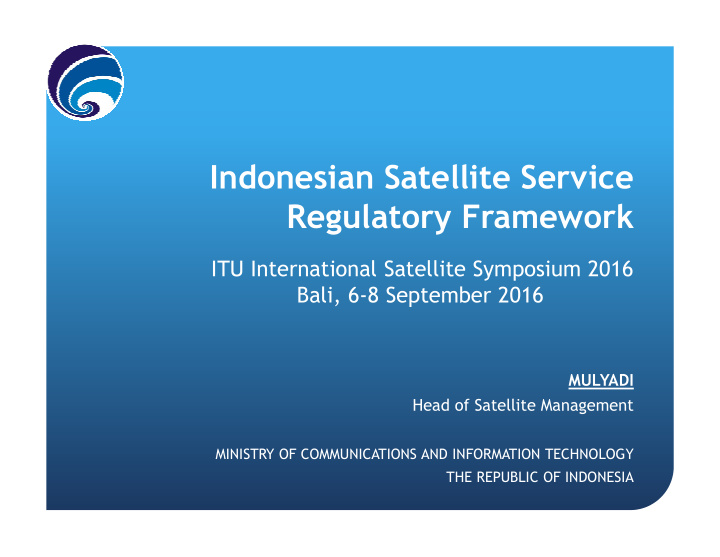



Indonesian Satellite Service Regulatory Framework ITU International Satellite Symposium 2016 Bali, 6-8 September 2016 MULYADI Head of Satellite Management MINISTRY OF COMMUNICATIONS AND INFORMATION TECHNOLOGY THE REPUBLIC OF INDONESIA
Indonesia: an overview • The largest archipelago country : 17,508 Population : 257 million • islands • 4th largest population in the world • Area: total land area: 1,904,569 km 2 ( land: – • GDP (2015) : USD 861.9 1,811,569 km 2 , inland water: 93,000 km 2 ) billion • The distance from East to West is around 5,236 • 16th largest economy km. Same distance from London to Teheran – (around 5,300 km) – Same distance from Lisbon to Boston (around 5,128 km) across the Atlantic Ocean
Indonesian Information Infrastructure Backbone Network : Fiber Optic Terrestrial backbone network : • • Cover West and Central Part of Indonesia • lack in Eastern Part of Indonesia • Government program to connect main islands with fiber optic “Palapa Ring” • Access network : • Cellular access covered Access Network : Cellular network most city • Lack in Eastern Part of Indonesia. • Blank spots only served by satellite infrastructure
Indonesian Information Infrastructure Satellite Specific Earth station Satellite plays an important • (C band) role in connecting Indonesian territory and serving the unserved areas Satellite used in urban, rural • and remote area. • There is 21.683 C band earth station all Indonesia. • Indonesia is highly dependent on satellite Java and Sumatera Islands with well covered by terrestrial infrastructure (fiber optic and cellular) still need satellite
Satellite Industry � Indonesia has used satellite communication since 1976 with Palapa satellite as the first satellite launched. � Currently, Indonesian has 9 satellite, 6 GSO and 3 NGSO � Capacity : � 155 txp C and � 14 txp Ku � Growth in C-band transponder due to the need of commercial cellular backbone � Strong growth in Ku-band transponder supplemented by good gains in video distribution (DTH) and enterprise data (VSAT) � Not enough supply from national satellite � Satellite usage in Indonesia : � 65% for Cellular backhaul � 24% for Broadcasting � Others : Banking, Plantation, Mining, Marine, Transportation, Industry
Indonesia’s Satellites Operator Satellite Orbit Type Freq Telkom Telkom-1 108 and 118 FSS C, Ku Telkom -2 Indosat Palapa-D 113 FSS C, Ku PSN Palapa-C2 146 FSS C MCI Indostar-2 108.2 BSS S (w/ SES-7) BRI Brisat 150.5 FSS C, Ku LAPAN Lapan-Tubsat NGSO Earth monitoring UHF , Lapan A2 Orari S, X Lapan A3
Indonesia’s Satellites NGSO LAPAN-TUBSAT LAPAN A2 LAPAN A3 113E 118E 123E 146E 108E 108.2E 150.5E PALAPA C-2 TELKOM-1 INDOSTAR-2 PALAPA-D TELKOM-2 BRISAT PT. INDOSAT PT. Telkom • PT. MCI PT. INDOSAT PT. TELKOM PT. BRI Std-C : 24 Txpd C band : 24 Txpd Std-C : 24 Txpd Std-C : 24 Txpd S band : 10 Txpd C band : 36 Txpd Ext-C : 12 Txpd Ext-C : 11 Txpd Ku band : 9 Txpd Ku : 5 Txpd
Recent and Planned Launches LAPAN A3 BRISAT TELKOM-3S LAPAN A2 ORARI Orbit NGSO NGSO 150.5 E 118 E Freq. UHF ,S UHF , S C,Ku C, Ku Mission Earth Earth Communication Communicatio observation, observation, n Ship scientific monitoring, amateur Launch 28 September 22 June 2016 18 June 2016 Q1 2017 2015
No orbit Filing Satellite Filing and 1 106 CSM-106 2 107.7 INDOSTAR-107.7E-K 3 107.7 INDOSTAR-107.7XS Spectrum 4 108 TELKOM-108E 5 108 PALAPA-C2 108 PALAPA-B1-EC 6 � Only a telco operator can submit satellite network 108 PALAPA-B1 7 108.2 INDOSTAR-110E-K 8 filing to MCIT . 9 108.2 INDOSTAR-108.2XS 10 108.2 INDOSTAR-110E 11 111 CSM-111 � MCIT will evaluate a filing request before submit to 12 113 PALAPA-B2 13 113 PALAPA-C1-K ITU. 113 PALAPA-C1 14 113 PALAPA-C1-B 15 118 GARUDA-1 16 � No satellite filing fee except cost recovery from ITU. 17 118 TELKOM-3EK 18 118 PALAPA-B3 TT&C 19 118 INDOSTAR-118XS � Indonesian’s filing : 20 118 PALAPA-B3-EC 118 PALAPA-C3 21 � GSO : 118 PALAPA-B3 22 118 PALAPA-C3-K 23 � 35 unplanned band in 14 slot orbit 24 120.5 CSM-120 25 123 GARUDA-2 � 3 planned band in 3 slot orbit 26 137.9 CSM-137 27 144 PALAPA PACIFIC-144E � NGSO : 3 146 PSN-146E 28 146 PALAPA PAC-KU 146E 29 146 PALAPA PAC-C 146E 30 � Satellite spectrum policy: 31 150.5 PALAPA-C4-K 32 150.5 PALAPA-C4-B 33 150.5 PALAPA-C4 � keep satellite spectrum in C, Ku and Ka band for 34 150.5 PALAPA-C4-A satellite not for IMT . 35 116.1 NUSANTARA-H1-30B 36 NGSO LAPAN-A3-SAT 37 NGSO LAPAN-TUBSAT 38 NGSO LAPANSAT
Foreign Satellite Usage • Foreign satellites may only provide transponder through the Indonesian telecommunications operator. • Foreign satellites must comply with landing right requirements. • Landing right requirements : • No harmful interference to the Indonesian satellite network; • Completed coordination with the Indonesian satellite network; • Reciprocity • There are 32 foreign satellite provide services in Indonesia. Main usage for cellular backhaul and broadcasting DTH •
Conclusion � Satellite plays an important role in connecting the country and serving the unserved areas in Indonesia � INDONESIA still needs more satellite capacity since “The EAST” is not connected yet (broadband) � MCIT encourages Indonesian operators to grow and expand its coverage and services to all of Indonesia � MCIT welcomes satellite operators foreign and domestic to serve Indonesia subject to the national regulation
Recommend
More recommend